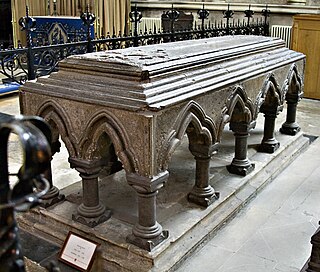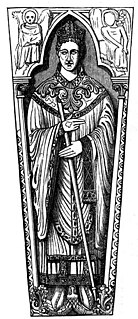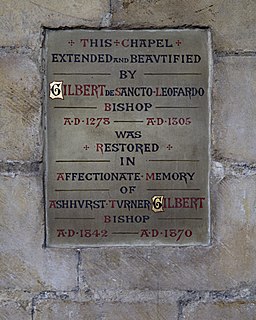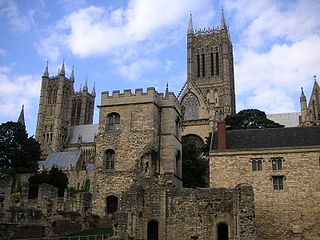Related Research Articles
Robert Winchelsey was an English Catholic theologian and Archbishop of Canterbury. He studied at the universities of Paris and Oxford, and later taught at both. Influenced by Thomas Aquinas, he was a scholastic theologian.
John de Gray or de Grey was an English prelate who served as Bishop of Norwich, and was elected but unconfirmed Archbishop of Canterbury. He was employed in the service of Prince John even before John became king, for which he was rewarded with a number of ecclesiastical offices, culminating in his pro forma election to Norwich in 1200. De Gray continued in royal service after his elevation to the episcopate, lending the King money and undertaking diplomatic missions on his behalf. In 1205 King John attempted to further reward de Gray with a translation to the archbishopric of Canterbury, but a disputed election process led to de Gray's selection being quashed by Pope Innocent III in 1206.
Thurstan or Turstin of Bayeux was a medieval Archbishop of York, the son of a priest. He served kings William II and Henry I of England before his election to the see of York in 1114. Once elected, his consecration was delayed for five years while he fought attempts by the Archbishop of Canterbury to assert primacy over York. Eventually, he was consecrated by the pope instead and allowed to return to England. While archbishop, he secured two new suffragan bishops for his province. When Henry I died, Thurstan supported Henry's nephew Stephen of Blois as king. Thurstan also defended the northern part of England from invasion by the Scots, taking a leading part in organising the English forces at the Battle of the Standard (1138). Shortly before his death, Thurstan resigned from his see and took the habit of a Cluniac monk.

Walter de Gray was an English prelate and statesman who was Archbishop of York from 1215 to 1255 and Lord Chancellor from 1205 to 1214. His uncle was John de Gray, who was a bishop and royal servant to King John of England. After securing the office of chancellor, the younger Gray was a supporter of the king throughout his struggles and was present at the signing of Magna Carta in 1215. After two unsuccessful elections to a bishopric, he became Bishop of Worcester in 1214 but soon after moved to York. During the reign of John's son, King Henry III, Gray continued to serve the king while also being active in his archdiocese. He died in 1255 and was buried at York Minster, where his tomb still survives.
Eustace was the twenty-third Lord Chancellor of England, from 1197 to 1198. He was also Dean of Salisbury and Bishop of Ely.
Walter Giffard was Lord Chancellor of England and Archbishop of York.
Philip of Poitou was Bishop of Durham from 1197 to 1208, and prior to this Archdeacon of Canterbury.
Henry Murdac was abbot of Fountains Abbey and Archbishop of York in medieval England.

Sewal de Bovil was a medieval Archbishop of York.
Henry of Newark was a medieval Archbishop of York.

Simon of Apulia was an Italian-born canon lawyer who served as Bishop of Exeter in Devon, England, from 1214 until his death in 1223.
William Langton was a medieval English priest and nephew of Archbishop Walter de Gray. William was selected but never consecrated as Archbishop of York and Bishop of Carlisle.
Simon of Wells was a medieval Bishop of Chichester.
John Climping was a medieval Bishop of Chichester.

Gilbert de St Leonard was a medieval Bishop of Chichester.

Hugh of Wells was a medieval Bishop of Lincoln. He began his career in the diocese of Bath, where he served two successive bishops, before joining royal service under King John of England. He served in the royal administration until 1209, when he was elected to the see, or bishopric, of Lincoln. When John was excommunicated by Pope Innocent III in November 1209, Hugh went into exile in France, where he remained until 1213.
Richard de Belmeis was a medieval cleric, administrator and politician. His career culminated in election as Bishop of London in 1152. He was one of the founders of Lilleshall Abbey in Shropshire.

Richard Marsh, also called Richard de Marisco, served as Lord Chancellor of England and Bishop of Durham.
Honorius of Kent was a medieval English Archdeacon of Richmond and canon lawyer.
Burchard du Puiset was a medieval Anglo-Norman clergyman and treasurer of the diocese of York. Either the nephew or son of Hugh du Puiset, the Bishop of Durham, Burchard held a number of offices in the dioceses of York and Durham before being appointed treasurer by King Richard I of England in 1189. His appointment was opposed by the newly appointed Archbishop Geoffrey, which led to a long dispute between Geoffrey and Burchard that was not resolved until the mid 1190s. After the death of Hugh du Puiset, Burchard was a candidate for the Hugh's old bishopric, but lost out in the end to another candidate. Burchard died in 1196.
References
- Bartlett, Robert C. (2000). England Under the Norman and Angevin Kings: 1075–1225. Oxford, UK: Clarendon Press. ISBN 0-19-822741-8.
- Cazel Jr, Fred A. (2004). "Langton, Simon (d. 1248)". Oxford Dictionary of National Biography. Oxford University Press. doi:10.1093/ref:odnb/16043.(subscription or UK public library membership required)
- Fryde, E. B.; Greenway, D. E.; Porter, S.; Roy, I. (1996). Handbook of British Chronology (Third Edition, revised ed.). Cambridge, UK: Cambridge University Press. ISBN 0-521-56350-X.
- Greenway, Diana E. (1971). "Canterbury: Archdeacons of Canterbury". Fasti Ecclesiae Anglicanae 1066–1300. Vol. 2: Monastic Cathedrals (Northern and Southern Provinces). Institute of Historical Research. Retrieved 15 September 2007.
- Greenway, Diana E. (1999). "Archbishops". Fasti Ecclesiae Anglicanae 1066–1300. Vol. 6: York. Institute of Historical Research. Retrieved 15 September 2007.
- Greenway, Diana E. (1999). "Prebendaries of Strensall". Fasti Ecclesiae Anglicanae 1066–1300. Vol. 6: York. Institute of Historical Research. Retrieved 15 September 2007.
- Joliffe, J. E. A. (1955). Angevin Kingship. London: Adam and Charles Black. OCLC 8936103.
- Poole, Austin Lane (1955). From Domesday Book to Magna Carta, 1087–1216 (Second ed.). Oxford, UK: Clarendon Press. ISBN 0-19-821707-2.
- Powell, J. Enoch; Wallis, Keith (1968). The House of Lords in the Middle Ages: A History of the English House of Lords to 1540. London: Weidenfeld and Nicolson. OCLC 463626.